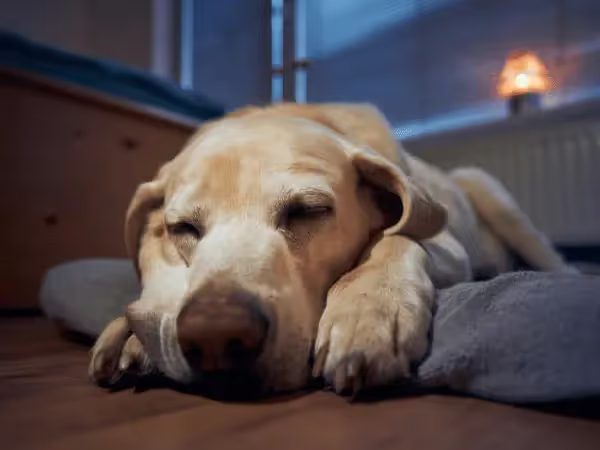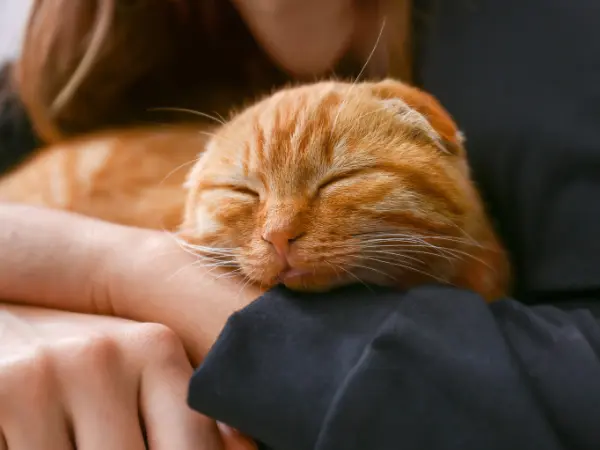Wondering if your dog is getting enough (or too much) sleep each day? Or maybe you’re curious to learn more about the meaning of different dog sleeping positions and behaviors.
Either way, sleep is a crucial part of every dog’s life. In this Sploot Vets guide, we talk about good sleep hygiene for dogs, as well as common dog sleeping positions and behaviors (and what they mean).
Overview:
- Dogs typically need more daily hours of sleep than humans.
- Dog sleeping positions and behaviors can provide clues about a dog’s sleep habits and emotional state.
- Dogs sleep best when they have a consistent daily routine and a comfortable sleeping environment.
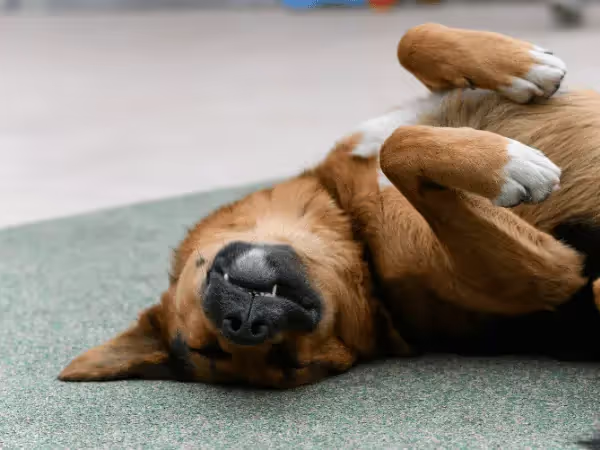
I. Dog Sleep 101: Duration & Pattern of Canine Sleep
A. How Many Hours Do Dogs Sleep?
Did you know that dogs typically need more hours of sleep than people? This is why you’ll often find your canine friend curled up on the couch or on their bed while the rest of the household goes about their day.
The amount of sleep a dog needs depends on their age and lifestyle. Here is a breakdown of how many hours of sleep they generally need:
- Newborns = Over 22 hours of sleep
- Puppies = 12 - 20 hours of sleep
- Adult dogs = 8 - 13.5 hours of sleep
- Working dogs = < 12 hours or more of sleep (depending on their role)
- Senior dogs = 16 - 18 hours of sleep
Note: Working dogs may sleep less than other dogs, but also tend to sleep more deeply due to the higher levels of daily physical activity.
B. A Dog’s Sleeping Pattern [Polyphasic]
Dogs naturally have a polyphasic sleep pattern, meaning they get their sleep requirements in short bursts. Essentially, dogs can distribute their sleep throughout the day, and it typically looks like this:
- Around 8 hours of sleep at night – As part of ‘pack behavior,’ many dogs adapt to their pet parent’s schedule, trying to sleep while their pet parent is also asleep.
- Naps throughout the day – These naps can last an average of 1 hour and 23 minutes each time, depending on the environment.
II. Dog Sleeping Positions
Dogs have a wonderful range of sleeping positions. Many of these positions reflect what’s comfortable for them and their emotional state.
1. Curled Up (Donut Pose)
The curled-up dog sleeping position is one of the most common among dogs, and it’s perfectly suited for bolstered dog beds. When a dog curls tightly into a ball, it’s usually to conserve warmth and protect vital organs. This position is common during cooler weather or when they’re seeking a sense of coziness.
2. Curled Up with Paws Over Face
Dogs that cover their faces while sleeping may be trying to stay warm or block out light and noise. This is often seen during lighter naps or when they want some quiet time during the day.
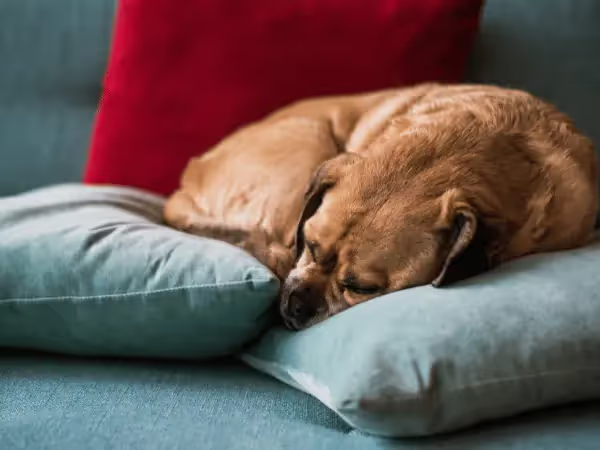
3. Side Sleeping
Dogs lying on their side are typically at ease, feeling secure and content in their surroundings. This relaxed position often signals they’re in a deep, restorative stage of sleep.
4. Belly-Up Dog Sleeping Position
When a dog sleeps flat on their back with their belly exposed, it’s a sign of total trust and comfort. Since the stomach is less insulated, it also helps them cool off during warm weather.
5. Twisted Belly-Up
Some dogs sprawl on their backs with their legs at funny angles, a quirky version of the belly-up dog sleeping position. This usually shows deep relaxation and complete comfort with their environment.
6. Flat on Their Belly
Common among puppies and energetic dogs, this position, with legs stretched out front and back, lets them rest while staying ready to spring up for play or attention.
7. Tucked Under Furniture or in Corners
Choosing a tight or sheltered space mimics a den environment and makes dogs feel safe and hidden. It’s a comforting choice for dogs seeking security or solitude, especially if trying to sneak a nap during the day inside an active household.
8. Belly-Down with Head on Paws (Resting Guard or Lion Pose)
In this position, dogs lie flat with their head resting gently on their paws. This dog sleeping position is common among guard dogs or dogs with a strong protective instinct, and it indicates that they’re still alert even while relaxed.
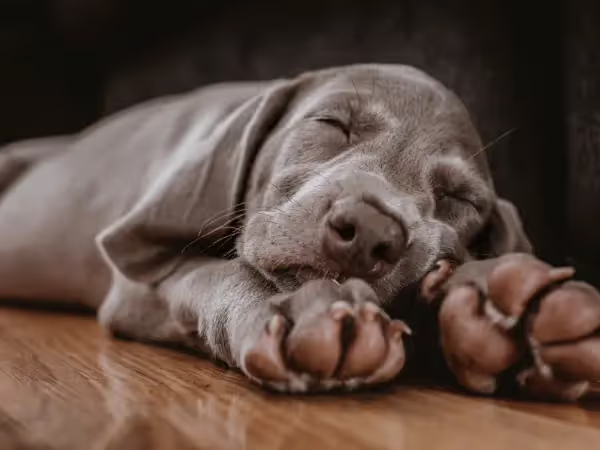
III. Dog Sleeping Behaviors – What Is Normal?
Dogs show a wide range of sleeping behaviors. Many of these are completely normal and reflect comfort or REM sleep (i.e., dreaming). However, some patterns, like excessive movement or disrupted sleep, can signal discomfort or health issues.
1. Dog Sleeping Too Much
Dog sleeping too much can be normal for puppies, seniors, or very active dogs, but excessive sleep may signal boredom, poor diet, or health issues. If your dog is unusually drowsy or lethargic, it’s best to check with a vet to rule out underlying health conditions.
2. Dog Sleeping Too Little
A dog sleeping too little is typically not normal and may be due to noisy environments or uncomfortable sleeping spots. Alternatively, lack of sleep in dogs can signal dog pain, itching, joint problems, separation anxiety, general anxiety, or other issues. If you’ve given your dog a comfortable place to rest and they are still unable to sleep properly, it’s best to contact your veterinarian to diagnose the problem.
3. Dog Barking in Sleep
Dog barking in sleep is usually harmless; it happens when they dream during the REM stage, reacting to dream scenarios much like humans do. It’s a normal sign that your dog’s sleep is progressing normally, and this stage of sleep is beneficial for your dog’s cognitive health.
4. Dog Breathing Fast While Sleeping
A dog breathing fast while sleeping can be normal, especially during dreaming when their body mimics activity. However, if your dog exhibits this behavior consistently, it may indicate stress, overheating, or a respiratory issue. In such cases, it’s best to see a veterinarian.
5. Dog Breathing Heavy While Sleeping
A dog breathing heavily while sleeping might simply mean they’re in a deep sleep. However, if the heavy breathing is frequent, noisy, or labored, it could suggest breathing difficulties, which may need prompt veterinary attention.
6. Why Do Dogs Twitch In Their Sleep
Dogs often twitch in their sleep as their muscles relax while entering deeper sleep or while dreaming. This sleep behavior in dogs is normal. However, if the twitching appears intense, persistent, or is accompanied by distress, it may need prompt veterinary attention.
7. Why Do Dogs Sleep At Your Feet
When dogs sleep at your feet (or somewhere close to you), they’re doing so to feel safe and connected to you. This behavior in dogs aligns with pack behavior, where staying near their leader provides comfort and protection.

IV. Sleep Hygiene for Dogs [Helpful Tips]
A. The Best Sleep Environment for Dogs
Dogs sleep best when they get to sleep indoors, in a part of the house that is…
- Quiet and not high-traffic – hallways or common areas may not be ideal, especially in households with multiple people
- Dark or dimly lit – when dogs get to sleep in the dark, it helps their body produce melatonin, a hormone that regulates a dog’s sleep-wake cycle and supports relaxation, mood balance, and overall well-being.
- Consistent – dogs thrive on routine, so having a consistent sleeping spot helps them relax.
- Comfortable – the dog’s sleeping spot should be comfortably warm and have a dog bed suited to their preference and age.
- Near their owner – letting the dog sleep on the bed is a personal choice and is not always necessary. However, dogs can also feel safe and bonded to their pet parent just by sleeping near to them.
B. The Best Sleep Routine & Time for Dogs
Dogs thrive on structure and predictability. Therefore, a consistent sleep schedule will help your dog fall asleep faster and feel more rested. Here are a couple of things to get done a few hours before your dog’s sleep time:
- Their last meal of the day – around 2 to 3 hours before sleep. Eating too close to their sleep time can cause gas, bloating, or indigestion. This is especially important for larger dog breeds that are more prone to bloating that escalates to GDV.
- Final walk or exercise – around 1 hour before sleep (as long as it’s safe in your area)
Note: The closer you are to the target sleep time for your dog, the gentler the interactions should be. Avoid any exciting or agitating activities closer to your dog’s bedtime.
Final Thoughts: Dog Sleep 101 & Dog Sleeping Positions
This concludes our guide on maintaining great sleep hygiene for your dog, along with some helpful information on dog sleeping positions and common sleeping behaviors. Helping your dog have consistent, restful sleep is just one aspect of their routine care. For more helpful tips, check out our vet-approved guides:
- Routine Dog Care for Health & Well-Being [Vet-Approved Checklist]
- How to Brush or Clean a Dog's Teeth at Home [2 Vet-Approved Ways]
- Dog Vaccines: Types, Schedules, & More [Vet-Approved Guide]
- 8 Amazing Ways to Bond with Your Dog [Complete Guide]

Sploot Vets: All-in-One Vet Care for Your Dog’s Wellness
Whether you’re curious about your dog’s sleep habits or need expert advice on their overall wellbeing, we are here for you!
Sploot Vets is your partner in helping your dog stay at their healthiest and happiest. We provide all-in-one veterinary care for your dog’s health (preventive care, urgent care, and emergency services), including support for sleep and behavioral issues.
Our Fear Free approach benefits all dogs, including anxious dogs, puppies, and senior dogs. Our dedicated team is here to provide top-tier care while ensuring your furry friend’s comfort.
With vet clinics in Chicago, Denver, and Colorado Springs, we’re open 365 days a year with extended hours that fit your schedule. Whether your pup needs behavioral support, a wellness exam, or urgent vet care, we are here for you!
Easily book an appointment online or through the Sploot Vets app!


